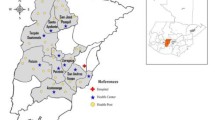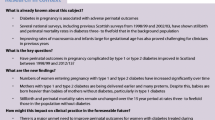Abstract
Objectives: To examine the incidence and temporal trends of hospitalization during pregnancy, and provide additional information on maternal morbidity among Canadian women. Methods: A population-based cohort study was conducted using the Canadian Institute for Health Information’s Discharge Abstract Database between fiscal year 1991/92 and 2002/03. This database included antenatal hospitalizations for all hospital deliveries (N=3,103,365) in Canada except for those occurring in Manitoba and Quebec. Temporal trends, and variations in the non-delivery antenatal hospitalization ratio (per 100 deliveries) by maternal age and province or territory were quantified. Primary causes for antenatal hospitalization, the lengths of in-hospital stay, and changing pattern by maternal age and time period were compared. Results: The overall antenatal hospitalization ratio declined by 43%, from 24.0 per 100 deliveries in 1991/92 to 13.6 in 2002/03. Younger women tended to be hospitalized more frequently than older women: 27.1 per 100 deliveries for women aged less than 20 years and 21.5 per 100 deliveries for 20–24 years, respectively, compared to 11.5 per 100 for women aged 35–39 years. The antenatal hospitalization ratio varied greatly by province/territory – from 12.2 per 100 deliveries in Ontario to 30.7 in the Yukon. Threatened preterm labour, antenatal hemorrhage, hypertensive disorders, severe vomiting and diabetes remained the five most common causes for antenatal hospitalization, although the trends for the first four declined dramatically from 1991/92 to 2002/03. Younger women were more likely to be admitted for threatened preterm labour and severe vomiting, while older women were more likely to be admitted for antenatal hemorrhage and hypertensive disorders. Conclusions: The decline in antenatal hospitalization may reflect changes in management of pregnancy complications, e.g., transition from in-hospital care to out-of-hospital care, and introduction of antepartum home care programs. Information on interprovincial/territorial variations in antenatal hospitalization may be helpful in directing future maternal health care.



Similar content being viewed by others
References
Bennett TA, Kotelchuck M, Cox CE, Tucker MJ, Nadeau DA. Pregnancy-associated hospitalizations in the United States in 1991 and 1992: A comprehensive view of maternal morbidity. Am J Obstet Gynecol 1998;178:246–54.
Bacak SJ, Callaghan WM, Dietz PM, Crouse C. Pregnancy-associated hospitalizations in the United States, 1999–2000. Am J Obstet Gynecol 2005;192:592–7.
Haas JS, Berman S, Golderg AB, Lee LWK, Cook EF. Prenatal hospitalization and compliance with guidelines for prenatal care. Am J Public Health 1996;86:815–9.
Liu S, Heaman M, Kramer MS, Demissie K, Wen SW, Marcoux S. Length of hospital stay, obstetric conditions at childbirth, and maternal readmission: A population-based cohort study. Am J Obstet Gynecol 2002;187:681–7.
Rostad B, Schei B. Factors predicting antenatal hospital admission in pregnancy. Scand J Prim Health Care 1998;16:85–9.
Scott C, Chavez G, Atrash HK, Taylor DJ, Shah R, Rowley D. Hospitalizations for severe complications of pregnancy, 1987–1992. Obstet Gynecol 1997;90:225–9.
Franks AL, Kendrick JS, Olson DR, Atrash HR, Saftlas AF, Moien M. Hospitalization for pregnancy complications, United States, 1986 and 1987. Am J Obstet Gynecol 1992;166:1339–44.
Health Canada. Maternal Mortality and Severe Morbidity. Ottawa: Ministry of Public Works and Government Services Canada. 2004.
Wen SW, Huang L, Liston R, Heaman M, Baskett T, Rusen ID, et al. for the Maternal Health Study Group of the Canadian Perinatal Surveillance System. Severe maternal morbidity in Canada, 1991/92 to 2000/01. CMAJ 2005; 173:759–63.
Wen SW, Rusen ID, Walker M, Liston R, Kramer MS, Baskett T, et al. for the Maternal Health Study Group of the Canadian Perinatal Surveillance System. Comparison of maternal mortality and morbidity between trial of labour and elective cesarean section among women with previous cesarean delivery. Am J Obstet Gynecol 2004;191:1263–9.
Adelson PL, Child AG, Giles WB, Henderson-Smart DJ. Antenatal hospitalization in New South Wales, 1995–96. MJA 1999;170:211–5.
Little RE, Little AS, Chislovska N, Hulchiy OP, Monaghan SC, Gladen BC. Hospital admissions during pregnancy in two urban areas of Ukraine. Paediatr Perinat Epidemiol 2001;15:323–7.
Gazmararian JA, Petersen R, Jamieson DJ, Schild L, Adams MM, Deshpande AD, et al. Hospitalizations during pregnancy among managed care enrollees. Obstet Gynecol 2002;100:94–100.
Werchler T. Pregnancy-related hospital use. Health Reports (Statistics Canada, Catalogue 82–003-XPB) 1998;10:21–7.
Health Canada. Canadian Perinatal Health Report 2003. Ottawa: Ministry of Public Works and Government Services Canada. 2003.
Liu S, Heaman M, Joseph KS, Liston RM, Huang L, Sauve R, et al. for the Maternal Health Study Group of the Canadian Perinatal Surveillance System. Risk of maternal postpartum readmission associated with mode of delivery. Obstet Gynecol 2005;105:836–42.
Wen SW, Liu S, Marcoux S, Fowler D. Uses and limitations of routine hospital admission separation records for perinatal surveillance. Chronic Dis Can 1997;18:113–9.
Heaman M. Psychosocial impact of high-risk pregnancy: Hospital and home care. In Hill W., editors. Ambulatory Obstetrics. New York: Lippincott Williams & Wilkins, 2002. pp. 194–212.
Heaman M, Gupton A. Perceptions of bed rest by women with high-risk pregnancies: A comparison between home and hospital. Birth 1998; 25:252–8.
Helewa M, Heaman M, Dewar L. Community-based antenatal home care programme for the management of preterm premature rupture of membranes. J Obstet Gynaecol Can 2001;22:928–35.
Helewa M, Heaman M, Robinson M, Thompson L. Community based home care program for management of preeclampsia: A viable alternative. CMAJ 1993;149:829–34.
Salvador A, Davies B, Fung Kee Fung K, Clinch J, Coyle D, Sweetman A. Program evaluation of hospital-based antenatal home care program for high-risk women. Hosp Q 2003, Spring:67–73.
Harrison M, Kushner K, Benzies K, Kimak C, Jacobs P, Mitchell B. In-home nursing care for women with high-risk pregnancies: Outcomes and cost. Obstet Gynecol 2001;97:982–7.
Goulet C, Gevery H, Lemay M. A randomized clinical trial of care for women with preterm labour: home management versus hospital management. CMAJ 2001;164:985–91.
Abenhaim HA, Morin L, Benjamin A. Does availability of fetal firbonectin testing in the management of threatened preterm labour affect the utilization of hospital resources? J Obstet Gynaecol Can 2005;27:689–94.
Tekesin I, Wallwiener D, Schmidt S. The value of quantitative ultrasound tissue characterization of the cervix and rapid fetal fibronectin in predicting preterm delivery. J Perinat Med 2005;33:383–91.
Delvaux T, Buekens P, Godin I, Boutsen M. Barriers to prenatal care in Europe. Am J Prev Med 2001;21:52–9.
Droste S, Keil K. Expectant management of placenta previa: cost-benefit analysis of outpatient treatment. Am J Obstet Gynecol 1994;170:1254–7.
Mouer JR. Placenta previa: Antepartum conservative management, inpatient versus outpatient. Am J Obstet Gynecol 1994;170:1683–6.
Love CD, Wallace EM. Pregnancies complicated by placenta previa: what is appropriate management? Br J Obstet Gynaecol 1996;103:864–7.
Tuffnell DJ, Lilford RJ, Buchan PC, Prendiville VM, Tuffnell AJ, Holgate MP, et al. Randomised controlled trial of day care for hypertension in pregnancy. Lancet 1992;339:244–7.
Carlan SJ, O’Brien WF, Parsons MT, Lense JJ. Preterm premature rupture of membranes: A randomized study of home versus hospital management. Obstet Gynecol 1993;81:61–4.
Dunlop L, Umstad M, McGrath G, Reidy K, Brennecke S. Cost-effectiveness and patient satisfaction with pregnancy day care for hypertensive disorders of pregnancy. Aust N Z J Obstet Gynaecol 2003;43:207–12.
Turnbull DA, Wilkinson C, Gerard K, Shanahan M, Ryan P, Griffith EC, et al. Clinical, psychosocial, and economic effects of antenatal day care for three medical complications of pregnancy: a randomised controlled trial of 395 women. Lancet 2004; 363:1104–9.
Brooten D, Kaye J, Pouasse SM, Nixon-Jensen A, McLean H, Brooks LM, et al. Frequency, timing, and diagnoses of antenatal hospitalizations in women with high-risk pregnancies. J Perinatol 1998; 18:372–6.
Adams MM, Harless FE, Samo AP, Read JA, Rawlings JS. Antenatal hospitalization among enlisted serviceswoman, 1987–1990. Obstet Gynecol 1994;84:35–9.
Liu S, Wen SW. Development of record linkage of hospital discharge data for the study of neonatal readmission. Chronic Dis Can 1999;20:77–81.
Acknowledgments
This study was carried out under the auspices of the Canadian Perinatal Surveillance System (CPSS). Contributing members of the Maternal Health Study Group include: Tom Baskett (Dalhousie University), William Fraser (University of Montreal), Ling Huang (Public Health Agency of Canada), KS Joseph (Dalhousie University), Catherine McCourt and Hajnal Molnar-Szakacs (Public Health Agency of Canada). Drs. Heaman and Kramer are career scientists of the Canadian Institutes of Health Research (CIHR).
Author information
Authors and Affiliations
Consortia
Corresponding author
Rights and permissions
About this article
Cite this article
Liu, S., Heaman, M., Sauve, R. et al. An Analysis of Antenatal Hospitalization in Canada, 1991–2003. Matern Child Health J 11, 181–187 (2007). https://doi.org/10.1007/s10995-006-0154-3
Received:
Accepted:
Published:
Issue Date:
DOI: https://doi.org/10.1007/s10995-006-0154-3




